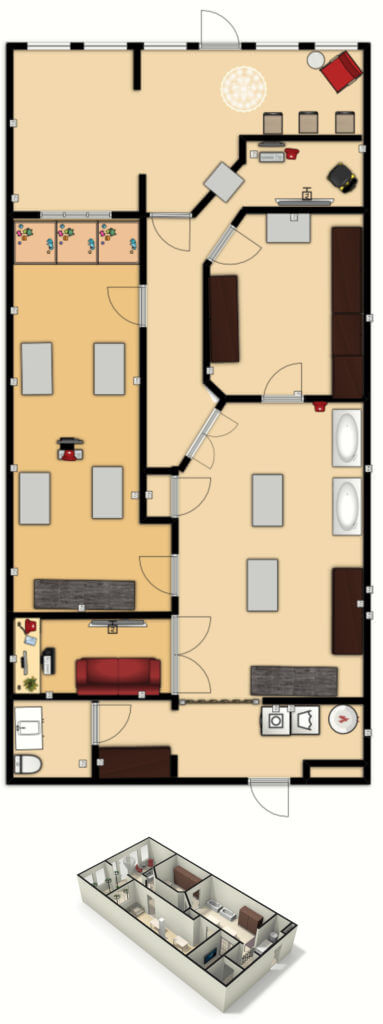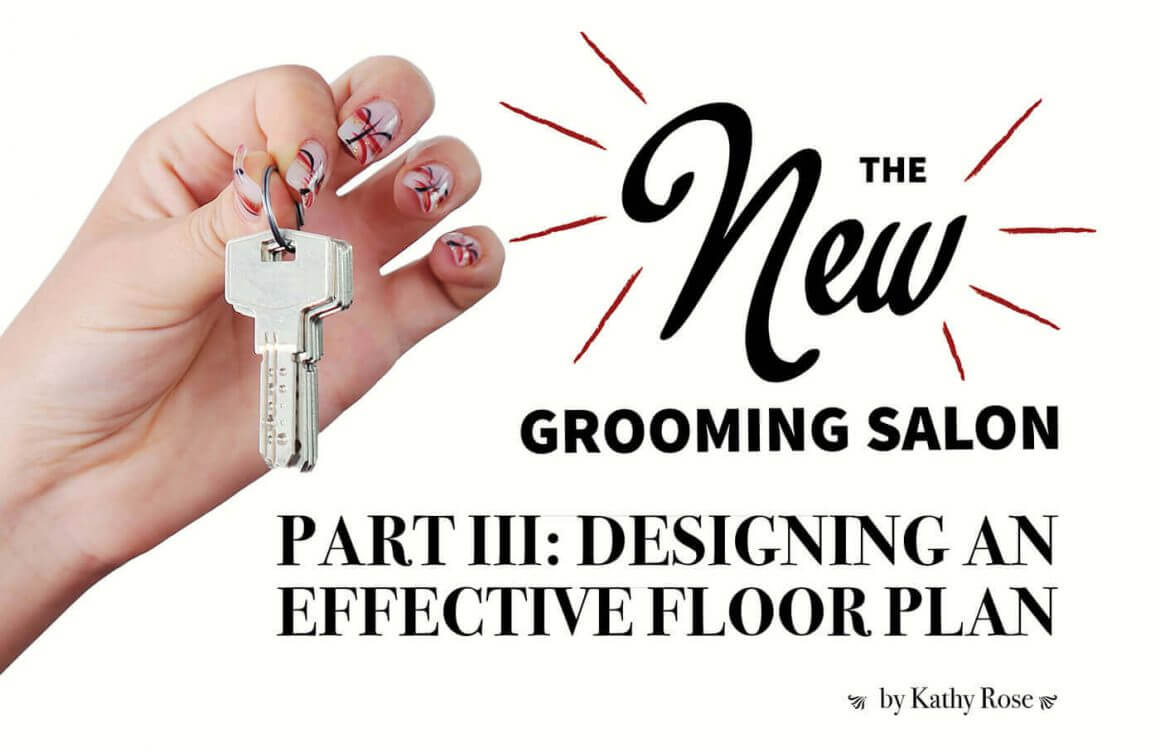By Kathy Rose
Creating an effective floor plan is crucial for an efficient salon. Well organized salons have at least four area considerations in their floor plan. Smaller salons may combine spaces but regard should be given to the tasks at hand:
- Receiving & Evaluating Clients
- Holding Area (for pets during their stay)
- Bathing & Drying (the “Wet” room)
- Styling & Finishing
Even the smallest space should incorporate the four main areas into the salon design. Keep in mind, as the salon size increases so does the importance of the floor plan. This will require exact measurements of the space you have chosen. Being just a little bit off in measuring can prove to be frustrating and costly when installing large equipment such as kennel banks and tubs.
It is also important to consider the size of the walls where large equipment will be placed. An error by an inch can cost a lot of money in redesign, construction or product return. Consider how the doors, including cage doors, open in relation to adjacent walls. It is difficult to place a large dog in a cage adjacent to a wall when it opens away from the wall instead of toward the wall.
Larger salons should incorporate multiple access points within the salon from styling room to wet room, to kennel room to reception. It is important to consider the order of things; dogs check in, go to holding area, proceed to bathing and drying and then perhaps back to holding area prior to being groomed in the styling area.
There are many useful programs and application tools available via the Internet for designing a space. I have found www.floorplanner.com to be the most user friendly. This site is cost effective and provides video tutorials that are easy to follow. The floor plans pictured are some examples of plans created using this program.
 Creating the Plan
Creating the Plan
Walking through your prospective space should ignite a spark of creativity. Keep the four areas in mind when evaluating the space.
The first impression should be warm and inviting. Pick a theme and carry this throughout the salon. Modern, antique, country, whatever your choice, carry it throughout your salon in your design plan.
Reception
An important part of reception is the evaluation area. A designated area for evaluating the clients’ pets helps to reduce stress and can serve as a holding area while pertinent information is gathered.
Your initial reception of clients will set the pace of the entire experience. They deserve the time and attention for a thorough evaluation, especially on the first visit. This space will say, “I care about you and your fur baby!” Perhaps even more importantly, this initial evaluation provides the opportunity for you to interact with the client and pet and create a bond. Placing the pet on the front desk or evaluating small pets on the floor does not speak professionalism. Set up a designated table for pet evaluation.
This area is also a great space for record keeping. It is imperative to keep track of every pet and what takes place at every visit. A reception desk housing a file cabinet, cash drawer, computer, printer, phone and office supplies should have integrated electrical and phone outlets. A battery back up system is advisable. Take accurate measurements to insure that integral equipment will fit in the allotted space.
The reception area is a prime location to offer retail items. Even the smallest salon can offer some retail to earn a bit of extra income. Sell what you use and use what you sell. Items such as shampoos, conditioners, combs, brushes, and other grooming and styling products are easy to stock and display. Clients look to you for advice about their pets and these items encourage a dialogue about coat management.
The front reception area should provide an added measure of safety to minimize escapes. Inward swinging gates will help to create a safer atmosphere by blocking an escape route. Strategically placed magnets and auto close hinges will help to secure the gates automatically.
Holding Area
Whether waiting for retrieval by the pet parent or waiting for a procedure, at some point during a pet’s visit he will require a place to wait. The holding area should be a comfortable area where the pets can be easily monitored.
Remember that dogs will be dogs and dogs BARK! Evaluate the sound proof-ability of the interior walls and ceiling. Consideration should be given to minimize the transfer of noise to adjacent tenants. Installation of noise reducing insulation will help to keep your neighbors on friendly terms and reduce complaints to the landlord.
Kennels or cages are one consideration for housing. They should be comprised of non-porous materials with a comfortable floor and good ventilation.
Another consideration is a benching area. This method of holding the pets utilizes a benching system or table with dividers containing a leash to tether the pet to prevent escape. It is imperative to insure the pet is unable to reach the edge of the bench while tied.
Play pens or built-in enclosures are also popular and clients like the cage free feel. A variety of pen configurations are available with and without gates and may be more cost effective than those custom built. A mat, pee pad and fresh water help to provide a comfortable atmosphere for the pet.
An enclosed free play area for multiple dogs is another choice. Many dogs are not receptive to confinement and enjoy playtime with other pets.
You may choose to utilize a combination of housing options offering the client a choice at a price. Whichever method is employed the pets should always be carefully monitored.
Bathing and Drying
The bathing and drying area is best placed separate from the rest of the salon. An enclosed “wet” room will help control humidity, aid with hair containment and help to control dryer noise. This will reduce time spent keeping a clean shop and help to maintain a professional spa atmosphere.
Plan on the installation of an exhaust fan vented outside. This will help to expel the warmer air, reduce some humidity and provide an extra source of ventilation.
Ideally, all surfaces in the “wet” room will be made from water resistant materials such as tile board or tile. But all the areas adjacent to the tubs must be water resistant. If electrical outlets are to be placed near the wet areas be sure that they are ground fault protected or GFCI.
Styling and Finishing
The styling and finishing area is best stationed away from the wet room and near the reception area. Consider installing a “viewing” window for the clients. This will help contain trimmed hair and give clients the chance to view their pet’s grooming procedures, but at a distance.
Make sure to install abundant electrical outlets. Contemplate installing floor outlets during the build out. This will reduce the need for dangerous extension cords.
Lighting is also a major consideration for this room. Try to make use of as much window light as possible. Natural ambient light is easiest to work with. Track lighting is also a good option because you can direct the flow of light to avoid shadows.
Creating a Floor Plan that Flows
It is important to think of the separate areas discussed above. It is strategic to consider their spatial relationship to each other. How does the typical workday flow? Check in clients, proceed to holding area, bathing follows, next dryers, on to styling, and then inevitably back to holding area.
Create these areas relative to typical order of procedure. Avoid bottlenecks, especially in cramped spaces. Always take into consideration the direction of door opening and alter this if needed. It is much more efficient to change door opening direction during the initial build-out rather than in hindsight after the painting has been completed.
Designing your floor plan is a strategic part in the build-out of your new salon. Creating an efficient plan and following some basic concepts can help you to create the salon of your dreams. ✂
Next month: Part IV Hiring a General Contractor & Understanding Terms
